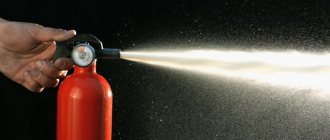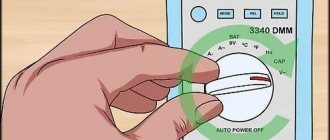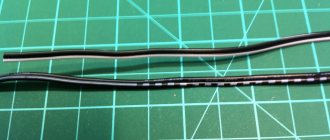Procedure in the event of an electrical fire in an apartment
Electricity makes human life more comfortable and convenient. At the same time, it is a source of increased danger, causing more than half of the fires occurring in the country. As a result, people die, expensive property is destroyed, and residential buildings and commercial structures become unusable. When purchasing real estate, its owners cannot know about the condition of the wiring installed in it and the purchased household appliances. Knowing what to do if the wiring catches fire, you can quickly and without serious consequences avoid an emergency situation.
Main reasons
An electrical fire can occur in the following situations:
- Short circuit. In this case, the temperature in the damaged area increases several times, melting the electrical wiring strands. Occurs due to breakdown of the insulating material (mechanical damage, microcracks, increased voltage, old electrical wiring).
- Network overload current. It is typical when connecting electrical equipment of increased power, the appearance of large leakage currents, and an increase in temperature in certain areas. These reasons also lead to overheating and subsequent fire.
- Often electrical wiring burns at the junction of current-carrying conductors. As a result of weakening or oxidation of the contact, the contact resistance of the electrical wiring sharply increases, which entails overheating and subsequent fire.
The most common cause of electrical fire is a faulty or damaged power cord for electrical appliances. If this happens, the first thing you need to do is disconnect the device from the mains, cover the fire area with a rag and put out the fire. Most apartments have flower pots, the soil from which is perfect for putting out flames.
Features of extinguishing depending on voltage
When extinguishing electrical equipment, it is necessary to take into account the voltage value. If we are talking about installations whose characteristics exceed 10 kV, it will not be possible to cope with a strong fire on your own, so you should call the fire department.
Depending on the voltage characteristics, powder or carbon dioxide fire extinguishers should be used.
The occurrence of a fire in electrical installations is much easier to prevent than to eliminate its consequences. To do this, you must ensure that the equipment is in good working order and is operating in accordance with the specifications.
Also read: How many electrical safety clearance groups are there?
Requirements for fire extinguishers
Any fire extinguisher must be supplied with a passport from the manufacturer and a serial number according to the accounting system of the operating organization. The trigger mechanism is equipped with a protective seal, which is installed by the verification company or the manufacturer.
Also read: Stray currents
The enterprise must organize control over the serviceable condition of fire extinguishers and their timely checking and recharging. The specified fire extinguishing means must be placed in convenient places, in close proximity to the place of possible use, located at a height of 1.5 m from the floor level.
According to government regulations, fire extinguishers must meet the following requirements:
- allow their use by one person with the ability to process the area, according to the technical specifications from the manufacturer;
- exclude the occurrence of danger to humans during use;
- have the necessary strength to ensure safety of use.
The distance of fire extinguishers from a possible source of fire is from 20 to 70 m, depending on the class of the room in terms of explosion and fire hazard.
What to do if the lights go out and the apartment loses power?
It always happens at the wrong time: bam! and the light went out. Maybe there was something crackling in the socket or switch beforehand. Or maybe you turned on the light, the light bulb exploded and the traffic jams went out, and there is no light throughout the apartment. But sometimes it happens that the kettle and microwave are turned on at the same time and at the same time, there is also no light, the machine turns off due to overload. The reasons and circumstances can be very different. Let's figure out how to act in this situation.
First of all, you need to find out under what circumstances the lights went out.
If, for example, the light goes out when an electrical appliance is turned on, then that is most likely the reason. The device must be turned off immediately and not turned on again without checking. If this happened when the chandelier was turned on, then most often the lamp burned out, and the current surge knocked out the plug. The principle of operation of a circuit breaker is to disconnect the line during a current surge and protect it.
So, if the plugs in the dashboard are knocked out, what should you do?
If the reason for knocking out the plugs remains unknown, you should remove the plugs from all sockets and move the switches to a different position. These steps need to disconnect the area with damaged insulation.
Keeping in mind the presence of protection zones, figure out which plugs have burned out (which circuit breakers have turned off). First familiarize yourself with the diagram of a standard apartment switchboard. In this case, you need to be guided by the following considerations: if there are several groups in the apartment, but not all the lamps have gone out, but only the lamps belonging to one group, then there is no need to touch the plugs on the stairs - they are probably intact; if there are several groups in the apartment and all have gone out, there is nothing to do about the traffic jams in the apartment, but you need to look on the stairs or at the beginning of the riser.
But how can we figure out what kind of traffic jams caused the lights to go out in the apartment?
To do this, you need to know whether the light in other apartments powered by the same riser phase is working properly. If it works, look for it on your site. If the lights go out in several apartments, the problem is in the fuses at the beginning of the riser.
In staircases, you should never check fuses with a test lamp, because it is easy to get into a “foreign” phase, and the voltage between phases is 380 V (in the network 380/220 V), i.e. significantly higher than between phase and neutral (zero) 220 V introduced into apartments. Never insert screwdrivers, nails or other metal objects into fuses, even momentarily. If there is a short circuit in the network, then in the best case, such tests will blow the following fuses and instead of one group (apartment), the lights will go out in all groups (apartments). But it could end worse - the blinding light of the electric arc will burn your eyes.
For safe wiring repairs, contact a professional technician. To order electrician services in Korolev or place a call for an electrician in Mytishchi, immediately contact our operator as soon as the power goes out. If you need an electrician in Shchelkovo, call us, we will arrive within an hour.
The lights went out and you want to do the repairs yourself. Be careful!
When performing any electrical work, follow safety regulations.
To correct contacts in screw connections, the screws and nuts must be tightened tightly. If there are no washers, you need to add them. If the contact is poor because the wire is oxidized, dirty, or the insulation has not been thoroughly removed from it, you need to strip the wire.
If the contacts and sections of wires located near the contacts heat up, then the connection is loose and needs to be tightened.
If one device is damaged, but the rest are working, then you need to look for damage in that device. If a working lamp does not light up, the stove, iron, kettle, etc. do not heat up, then the problem is a broken contact: the lamp does not reach the contacts of the socket, the spiral is burnt out, the pin of the plug does not touch the socket, the wire is broken.
If there is a smell of burnt rubber, immediately look for a bad contact, and when you find it, fix it. Poor contact is a source of fire.
Keep in mind that usually either the contacts or the insulation are damaged.
Insulation failure leads to short circuits and blown fuses.
- Do not pull the plug by the wire. Straighten kinked wires and cords.
- Do not paint or whitewash fittings, cords and wires laid on rollers.
- Do not leave broken bases and covers of sockets, broken rollers, or exposed wires in use; cartridges with metal casings must be replaced.
- Under no circumstances should wiring for different purposes touch each other. After all, the apartment has wiring: telephone, radio broadcasting, antenna input. They require careful handling.
- Never hammer nails or drill into walls in apartments with hidden electrical wiring without determining where the wires may be laid. The furrows with wiring run along the shortest distances from the boxes to the installation sites of switches and plug sockets. They can go between boxes, between plug sockets installed in one row.
- Do not hang anything from wires.
- Poor contacts on switches are usually associated with failure. They break off. springy contact plates or they lose their elasticity. There is no point in repairing them, you just need to replace the switch.
How to prevent an electrical appliance from catching fire?
If there is something wrong with the equipment and there is a risk of a short circuit, then most often we can notice this in advance. We will be told by the specific smell of burning plastic or the strange sounds that an electrical appliance makes.
Sometimes sparks may also be visible. In these cases, you should immediately stop using the equipment, as the risk of fire is very high at this point. Don't neglect this rule. A small spark can lead to irreparable consequences.
Such equipment must either be replaced or taken to a workshop for repair. Once a specific smell occurs, forget that this device can be used at all.
Another rule that must be observed when using electrical appliances is that you should not overload the electrical network. That is, you can’t do it like this:
Correct actions in case of fire
First of all, it is necessary to take all measures to turn off the power to burning electrical appliances. You can do this in several ways:
- Unplug the device from the socket. This is only permitted if the flame does not damage the insulation on the plug, socket, or nearby sections of the wire.
- Turn off the circuit breaker that feeds the line (or the switch that supplies electricity to the room where the fire occurred).
- Use an ax to cut the cable or wire that supplies electricity to the burning appliance.
Please note that the device may be connected to a UPS or backup power source. Then it will remain energized even after the main line is turned off.
If for some reason it is impossible to de-energize the line on which the fire occurred, they begin to extinguish the fire with means that do not conduct current. If necessary, evacuation and notification of the fire service are also carried out.
If there are children in the room
In case of a fire, children behave differently than adults - most often they hide from the fire under the bed, in the closet, or climb into a corner. Even if you are sure that the house is safe, try to explain to the kids that in such cases they need to immediately run out of the room and under no circumstances return to it for forgotten things.
How to protect electrical wiring in an apartment from accidental fire? More details










